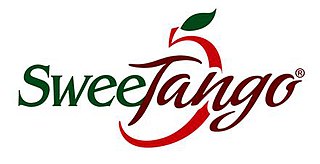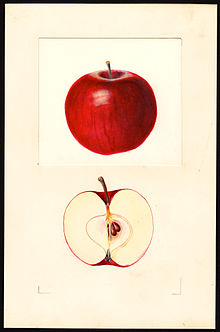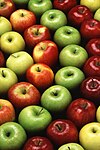
The Granny Smith, also known as a green apple or sour apple, is an apple cultivar which originated in Australia in 1868. It is named after Maria Ann Smith, who propagated the cultivar from a chance seedling. The tree is thought to be a hybrid of Malus sylvestris, the European wild apple, with the domesticated apple Malus domestica as the polleniser.
A beacon is an intentionally conspicuous device designed to attract attention to a specific location.

A cooking apple or culinary apple is an apple that is used primarily for cooking, as opposed to a dessert apple, which is eaten raw. Cooking apples are generally larger, and can be tarter than dessert varieties. Some varieties have a firm flesh that does not break down much when cooked. Culinary varieties with a high acid content produce froth when cooked, which is desirable for some recipes. Britain grows a large range of apples specifically for cooking. Worldwide, dual-purpose varieties are more widely grown.

The Haralson is a cultivar of apple that is medium-sized and has a round-conic shape.

Gala is a clonally propagated apple cultivar with a mild and sweet flavour and striped or mottled appearance. In 2018, it surpassed Red Delicious as the apple cultivar with the highest production in the United States, according to the US Apple Association. It was the first time in over 50 years that any cultivar was produced more than Red Delicious.

Honeycrisp is an apple cultivar developed at the Minnesota Agricultural Experiment Station's Horticultural Research Center at the University of Minnesota, Twin Cities. Designated in 1974 with the MN 1711 test designation, patented in 1988, and released in 1991, the Honeycrisp, once slated to be discarded, has rapidly become a prized commercial commodity, as its sweetness, firmness, and tartness make it an ideal apple for eating raw. "...The apple wasn't bred to grow, store or ship well. It was bred for taste: crisp, with balanced sweetness and acidity." It has larger cells than most apple cultivars, a trait which is correlated with juiciness, as theoretically a higher number of cells rupture when bitten, releasing more juice in the mouth. The Honeycrisp also retains its pigment well and has a relatively long shelf life when stored in cool, dry conditions. Pepin Heights Orchards delivered the first Honeycrisp apples to grocery stores in 1997. The name Honeycrisp was trademarked by the University of Minnesota, but university officials were unsure of its protection status in 2007. It is now the official state fruit of Minnesota. A large-sized honeycrisp will contain about 113 calories.

The Siberian elm cultivar Ulmus pumila 'Hansen' is a little-known American tree of obscure origin, possibly raised from seed collected by the horticulturist and botanist Prof. Niels Hansen during his expedition to Siberia in 1897.

An apple is an edible fruit produced by an apple tree. Apple trees are cultivated worldwide and are the most widely grown species in the genus Malus. The tree originated in Central Asia, where its wild ancestor, Malus sieversii, is still found today. Apples have been grown for thousands of years in Asia and Europe and were brought to North America by European colonists. Apples have religious and mythological significance in many cultures, including Norse, Greek, and European Christian tradition.
McIntosh, Macintosh, or Mackintosh may refer to:

The Zestar! apple or Minnewashta (cultivar) is an apple cultivar released in 1999. It was developed by the horticulturalists at the Minnesota Landscape Arboretum's Horticultural Resource Center, at the University of Minnesota.

The Arkansas Black is an apple cultivar that originated in the mid-19th Century in Benton County, Arkansas. It is not the same as the cultivar 'Arkansas' or 'Arkansas Black Twig'.

Belle de Boskoop is an apple cultivar which originated in Boskoop, Netherlands, where it began as a chance seedling in 1856. Variants include Boskoop red, yellow and green. This rustic apple is firm, tart and fragrant. Greenish-gray tinged with red, the apple stands up well to cooking. Generally Boskoop varieties are very high in acid content and can contain more than four times the vitamin C of Granny Smith or Golden Delicious.

SweeTango is the brand designation of the cultivated apple 'Minneiska'. It is a patented cross breed between the 'Honeycrisp' and the Zestar! apple. The trademark name belongs to the University of Minnesota. The apple is controlled and regulated for marketing, allowing only exclusive territories for growing. It has a sweet-tart taste that some food writers have described as something between brown sugar and spiced apple cider.

The Wealthy is an American apple cultivar, and was the earliest to thrive in the Minnesota climate. Horticulturalist Peter Gideon first grew it in 1868, after years of trial and error with various apple varieties.

The Ulmus pumila cultivar 'Aurescens' was introduced by Georg Dieck at the National Arboretum, Zöschen, Germany, circa 1885. Dieck grew the tree from seed collected in the Ili valley, Turkestan by the lawyer and amateur naturalist Vladislav E. Niedzwiecki while in exile there. Dieck originally named the tree U. pinnato-ramosaf.aurescens.

'Honeygold' is a cold-hardy cultivar of domesticated apple, which was developed to suit for the northern cold areas. It was developed by the Minnesota Agricultural Experiment Station's Horticultural Research Center of the University of Minnesota. They were crossing a Golden Delicious with a Haralson in order to obtain a Golden Delicious style fruit with the cold hardiness of the Haralson, a goal which was successfully achieved.
Sweet Sixteen is a cultivar of domesticated apple.

The malinda apple is a cultivar of domesticated apple, originating in New England., most likely Vermont.
Aia Ilu is a cultivar of domesticated apple, from Estonia, first developed in 1946 by Aleksander Siimon.

The MN55 cultivar apple developed by David Bedford, a senior researcher and research pomologist at the University of Minnesota's apple-breeding program, and James Luby, PhD, professor, Department of Horticultural Sciences, Horticultural Research Center, is a cross between Honeycrisp and MonArk (AA44), a non-patented apple variety grown in Arkansas.

















